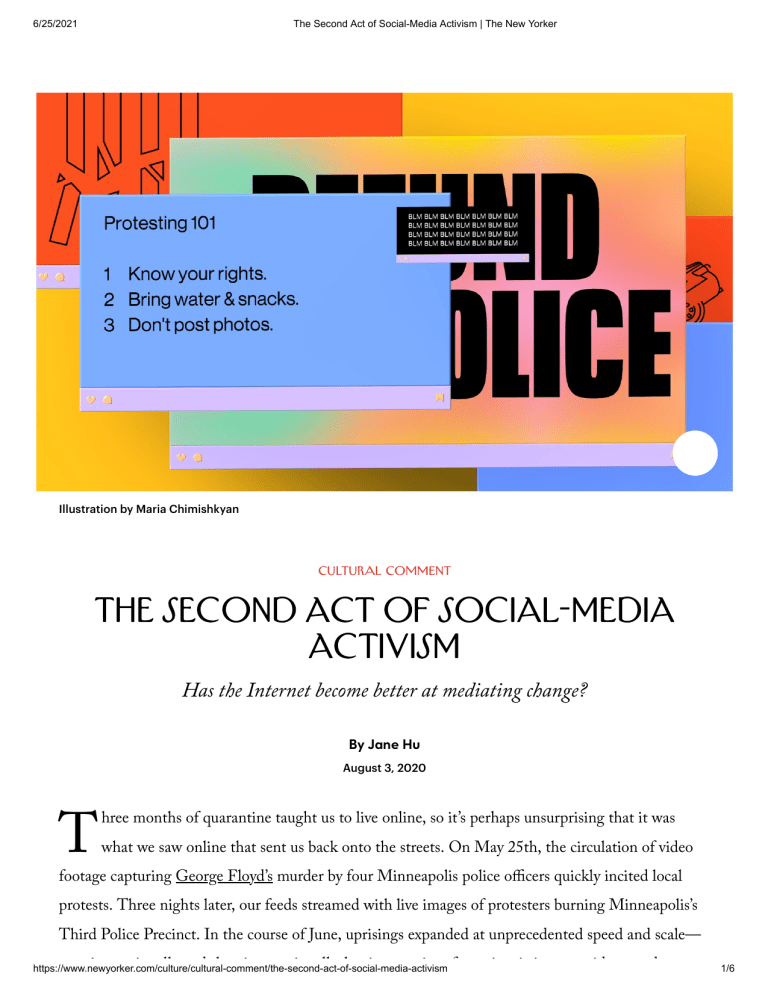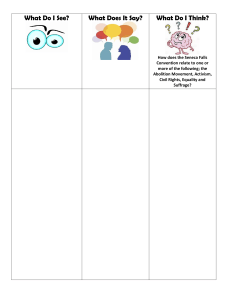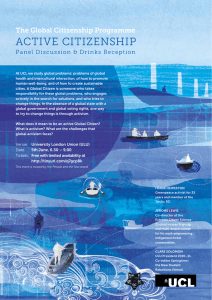
6/25/2021 The Second Act of Social-Media Activism | The New Yorker Illustration by Maria Chimishkyan Cultural Comment The Second Act of Social-Media Activism Has the Internet become better at mediating change? By Jane Hu August 3, 2020 T hree months of quarantine taught us to live online, so it’s perhaps unsurprising that it was what we saw online that sent us back onto the streets. On May 25th, the circulation of video footage capturing George Floyd’s murder by four Minneapolis police officers quickly incited local protests. Three nights later, our feeds streamed with live images of protesters burning Minneapolis’s Third Police Precinct. In the course of June, uprisings expanded at unprecedented speed and scale— i i ll d h i i ll l i i https://www.newyorker.com/culture/cultural-comment/the-second-act-of-social-media-activism f i i i id d 1/6 6/25/2021 The Second Act of Social-Media Activism | The New Yorker growing nationally and then internationally, leaving a series of now iconic images, videos, and exhortations in their wake. Every historic event has its ideal medium of documentation—the novel, the photograph, the television—and what we’re witnessing feels like an exceptionally “online” moment of social unrest. Indeed, the struggle in the public square has unfolded alongside a takeover of the virtual one. Amid cell-phone footage of protests and toppling statues, the Internet has been further inundated with what we might call activist media. Screenshots of bail-fund donations urging others to match continue to proliferate. Protest guides, generated from years of on-the-ground activist experience, are readily shared over Twitter and Instagram, telling readers how to blur faces in photographs or aid in de-arrests. There are e-mail and phone-call templates, pre-scripted and mass-circulated. Webinars about police abolition now constitute their own subgenre. And city-council meetings, which had already migrated to Zoom because of the pandemic, have come to host the hallowed activist tradition of town-hall agitation. (Well-timed appeals for the police department to “suck my dick,” it turns out, can be as effective online as off.) As some of June’s uprisings evolve into today’s encampments, the long revolutionary summer of 2020—made all the longer by quarantine—continues apace online. Some of this story may seem familiar. In “Twitter and Tear Gas: The Power and Fragility of Networked Protest,” from 2017, the sociologist Zeynep Tufekci examined how a “digitally networked public sphere” had come to shape social movements. Tufekci drew on her own experience of the 2011 Arab uprisings, whose early mobilization of social media set the stage for the protests at Gezi Park, in Istanbul, the Occupy action, in New York City, and the Black Lives Matter movement, in Ferguson. For Tufekci, the use of the Internet linked these various, decentralized uprisings and distinguished them from predecessors such as the nineteen-sixties civil-rights movement. Whereas “older movements had to build their organizing capacity first,” Tufekci argued, “modern networked movements can scale up quickly and take care of all sorts of logistical tasks without building any substantial organizational capacity before the first protest or march.” The speed afforded by such protest is, however, as much its peril as its promise. After a swift expansion, spontaneous movements are often prone to what Tufekci calls “tactical freezes.” Because they are often leaderless, and can lack “both the culture and the infrastructure for making collective decisions,” they are left with little room to adjust strategies or negotiate demands. At a more fundamental level, social media’s corporate infrastructure makes such movements vulnerable to https://www.newyorker.com/culture/cultural-comment/the-second-act-of-social-media-activism 2/6 6/25/2021 The Second Act of Social-Media Activism | The New Yorker coöptation and censorship. Tufekci is clear-eyed about these pitfalls, even as she rejects the broader criticisms of “slacktivism” laid out, for example, by Evgeny Morozov’s “The Net Delusion,” from 2011. “Twitter and Tear Gas” remains trenchant about how social media can and cannot enact reform. But movements change, as does technology. Since Tufekci’s book was published, social media has helped represent—and, in some cases, helped organize—the Arab Spring 2.0, France’s “Yellow Vest” movement, Puerto Rico’s RickyLeaks, the 2019 Iranian protests, the Hong Kong protests, and what we might call the B.L.M. uprising of 2020. This last event, still ongoing, has evinced a scale, creativity, and endurance that challenges those skeptical of the Internet’s ability to mediate a movement. As Tufekci notes in her book, the real-world effects of Occupy, the Women’s March, and even Ferguson-era B.L.M. were often underwhelming. By contrast, since George Floyd’s death, cities have cut billions of dollars from police budgets; school districts have severed ties with police; multiple police-reform-and-accountability bills have been introduced in Congress; and cities like Minneapolis have vowed to defund policing. Plenty of work remains, but the link between activism, the Internet, and material action seems to have deepened. What’s changed? T he current uprisings slot neatly into Tufekci’s story, with one exception. As the flurry of digital activism continues, there is no sense that this movement is unclear about its aims—abolition— or that it might collapse under a tactical freeze. Instead, the many protest guides, syllabi, Webinars, and the like have made clear both the objectives of abolition and the digital savvy of abolitionists. It is a message so legible that even Fox News grasped it with relative ease. Rachel Kuo, an organizer and scholar of digital activism, told me that this clarity has been shaped partly by organizers who increasingly rely on “a combination of digital platforms, whether that’s Google Drive, Signal, Messenger, Slack, or other combinations of software, for collaboration, information storage, resource access, and daily communications.” The public tends to focus, understandably, on the profusion of hashtags and sleek graphics, but Kuo stressed that it was this “back end” work—an inventory of knowledge, a stronger sense of alliance—that has allowed digital activism to “reflect broader concerns and visions around community safety, accessibility, and accountability.” The uprisings might have unfolded organically, but what has sustained them is precisely what many prior networked protests lacked: preëxisting organizations with specific demands for a better world. https://www.newyorker.com/culture/cultural-comment/the-second-act-of-social-media-activism 3/6 6/25/2021 The Second Act of Social-Media Activism | The New Yorker Some of this growth is simply a function of time. It has been seven years since Black Lives Matter was founded. Since then, groups such as the Movement for Black Lives—an explicitly abolitionist, anti-capitalist network that includes more than a hundred and fifty organizations—have lent unity and direction to a coalition that was once, perhaps, too diffuse to articulate shared principles. These groups have also become better at using the Internet to frame, formalize, and advance their agenda. As Sarah J. Jackson, Moya Bailey, and Brooke Foucault Welles write in “#HashtagActivism,” social media provides a digital “counterpublic,” in which voices excluded from “elite media spaces” can engage “alternative networks of debate.” When moments of rupture occur, this counterpublic can more readily make mainstream interventions. Recent discourse about prison and police abolition might be the clearest example of a shift in the Overton window, though Bailey points even to “the language that we’re hearing on television, white supremacy being named for what it is,” as unimaginable just a few years ago. What’s distinct about the current movement is not just the clarity of its messaging, but its ability to convey that message through so much noise. On June 2nd, the music industry launched #BlackoutTuesday, an action against police brutality that involved, among other things, Instagram and Facebook users posting plain black boxes to their accounts. The posts often included the hashtag #BlackLivesMatter; almost immediately, social-media users were inundated with even more posts, which explained why using that hashtag drowned out crucial information about events and resources with a sea of mute boxes. For Meredith Clark, a media-studies professor at the University of Virginia, the response illustrated how the B.L.M. movement had honed its ability to stick to a program, and to correct those who deployed that program naïvely. In 2014, many people had only a thin sense of how a hashtag could organize actions or establish circles of care. Today, “people understand what it means to use a hashtag,” Clark told me. They use “their own social media in a certain way to essentially quiet background noise” and “allow those voices that need to connect with each other the space to do so.” The #BlackoutTuesday affair exemplified an increasing awareness of how digital tactics have material consequences. Another example arrived on June 3rd, when Campaign Zero—a Black Lives Matter branch often associated with the activist DeRay Mckesson—launched a campaign, #8cantwait, to “reduce police violence.” The campaign endorsed a reformist platform, which included banning choke holds and https://www.newyorker.com/culture/cultural-comment/the-second-act-of-social-media-activism 4/6 6/25/2021 p g The Second Act of Social-Media Activism | The New Yorker p , g enforcing deëscalation training; it was widely circulated, and won support from names like Jon Lovett and Ariana Grande. By the end of that weekend, though, the campaign had been roundly criticized as too moderate—and perhaps even misleading, as many of its proposals had already been adopted— and it was abandoned by many within and without the B.L.M. movement. In response, a “group of abolitionist comrades,” in the words of the human-rights lawyer Derecka Purnell, presented a competing campaign with its own hashtag: #8toabolition. The immense speed with which #8toabolition was born and broadcast illustrates the tactical efficiency of today’s abolitionists. When I spoke to three of #8toabolition’s co-writers—Mon Mohapatra, Reina Sultan, and Rachel Kuo—over Zoom, they told me that their campaign’s demands were drafted by ten different activists in a shared Google doc in the course of twenty-four hours. That speed was enabled by the networks of trust and collaboration built through years of organizing. These networks suggest that digital activism has entered a second act, in which the tools of the Internet have been increasingly integrated into the hard-won structure of older movements. Though, as networked protest grows in scale and popularity, it still risks being hijacked by the mainstream. Any urgent circulation of information—the same memes filtering through your Instagram stories, the same looping images retweeted into your timeline—can be numbing, and any shift in the Overton window means that hegemony drifts with it. You know something has gone wrong when the San Francisco 49ers post a #BlackoutTuesday box. From the renaming (and repainting) of “Black Lives Matter Plaza” by the mayor of Washington, D.C., Muriel Bowser, to ahistorical citations of Martin Luther King, Jr.,’s speeches, the discourse of Black struggle remains open to aggressive co-optation. The meme-ification of Breonna Taylor’s death—in which calls to arrest her killers are prefaced by mundane observations about, say, the weather—may be the most depressing example yet of how social media can trivialize a movement. In “Twitter and Tear Gas,” Tufekci wrote, “The Black Lives Matter movement is young, and how it will develop further capacities remains to be seen.” The movement is older now. It has developed its tactics, its messaging, its reach—but perhaps its most striking new capacity is a sharper recognition of social media’s limits. “This movement has mastered what social media is good for,” Deva Woodly, a professor of politics at the New School, told me. “And that’s basically the meme: it’s the headline.” Those memes, Woodly said, help “codify the message” that leads to broader, deeper conversations offline, which, in turn, build on a long history of radical pedagogy. As more and more of us join those https://www.newyorker.com/culture/cultural-comment/the-second-act-of-social-media-activism 5/6 6/25/2021 , , , The Second Act of Social-Media Activism | The New Yorker g y p g gy j conversations, prompted by the words and images we see on our screens, it’s clear that the revolution will not be tweeted—at least, not entirely. Race, Policing, and Black Lives Matter Protests The death of George Floyd, in context. The civil-rights lawyer Bryan Stevenson examines the frustration and despair behind the protests. Who, David Remnick asks, is the true agitator behind the racial unrest? A sociologist examines the so-called pillars of whiteness that prevent white Americans from confronting racism. The Black Lives Matter co-founder Opal Tometi on what it would mean to defund police departments, and what comes next. The quest to transform the United States cannot be limited to challenging its brutal police. More: George Floyd Social Justice Social Media Activism Black Lives Matter Cookies Settings https://www.newyorker.com/culture/cultural-comment/the-second-act-of-social-media-activism 6/6


